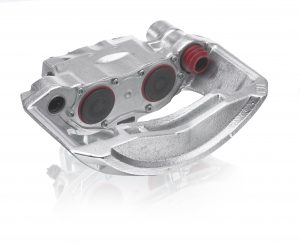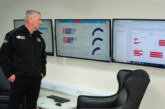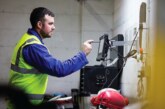
Highlighting its TRW branded offer of brake calipers for Heavy Commercial Vehicles, ZF Aftermarket asks whether the UK market is truly taking advantage of this method of production – and if not, to what cost?
As a market leader in the manufacture and supply of braking, steering & transmission components across all classes of vehicle, ZF Aftermarket says it has long championed remanufacturing as a viable method of production. Where possible, the business claims to remanufacture the highest quality automotive parts; providing greater efficiency, saving raw materials and labour, and offering significant cost savings to the consumer.
 When looking at the efficiency of production methods of braking parts for HCVs, there are a few indisputable facts, which the company says need to be taken into consideration.
When looking at the efficiency of production methods of braking parts for HCVs, there are a few indisputable facts, which the company says need to be taken into consideration.
Larger vehicles will have more axles to better distribute weight; reducing damage to road surfaces, allowing the vehicle to move more easily, over bridges for example which carry weight restrictions, and allowing the vehicle to carry large amounts of weight without the trailer malfunctioning. Depending of the configuration of the vehicle there are several calipers fitted. A typical vehicle on the UK roads could have three axle sets, with an average weight of 25-30 kilos each.
The second indisputable fact is that the heavier the load they have to carry, and the harsher the conditions in which they operate – the more stress these parts are subjected to.
OE quality
ZF Aftermarket says it takes all of this into account, when under its TRW brand it remanufactures its OE quality HCV air brake caliper range, at its own remanufacturing facilities. Stringent core acceptance criteria, disassembly and remanufacturing procedures – combined with 100% end of line testing – results in parts that perform exactly the way the VM intended, it adds.
The caliper’s modular design makes it the ideal candidate for remanufacturing. The TRW branded range of 60 plus references caters for VMs such as: MAN, Iveco, Scania, DAF and Mercedes-Benz – each caliper is supplied with accessories and fitting instructions.
True Original
These messages and more can be found in the HCV chapter of the TRW ‘True Originals’ campaign. In keeping with campaign concept of featuring a ‘True Original’, the star of this story is Erik Larsson. Erik is a truck driver from Sweden who delivers supplies across the Arctic Circle.
Jirka Horvath, Director Operations Remanufacturing at ZF Aftermarket, explains: “As part of the ZF Group, we are in a privileged position of having extensive access to the technologies that sit behind our parts. We use all this knowledge and experience to provide the World’s Vehicle Manufacturers and the Independent aftermarket with remanufactured parts that are quite simply, ‘as new’.”
Back to basics
The stopping power of a caliper is determined by its clamping force (the amount of force it can apply to the surface of a brake disc). This is primarily a function of the number of pistons and the surface area of the brake pad (where it actually contacts the brake disc). The greater the clamping force, the faster and more easily it can stop the vehicle. HCV calipers also have to deal with a lot of heat. Increased heat can lead to brake fade and reduced stopping distances, therefore good ventilation in the caliper is essential
for continuous, consistent brake performance.
Heavyweight testing
TRW says it tests all of its parts to the limit. In addition to industry standard checks, when assessing actuator functionality, the company tests that both brake pads move simultaneously and checks that the sensor indicator is performing correctly.
Looking to the future
Following two years of strong growth, according to the SMMT in the UK, the new HGV market declined slightly (2.6%) in 2017. Of 45,045 heavy trucks that were registered, tractors accounted for 43.1% and refuse collection vehicles experienced the biggest increase in demand, up 22.7% compared on 2016. With this overall growth, comes the need to create and fit the very best aftermarket components.
Benefits of remanufacturing
Given the sheer size and weight of HCV parts, the company says that the Global benefits of remanufacturing parts in a sustainable manner, reducing CO2eq and at a lower cost for the consumer, are clear.
From an ecological perspective, it’s a clever reuse of raw material with the returned core providing the basis of the next cycle of production, therefore helping to reduce landfill. Estimates suggest remanufacturing a part uses only 55% of the energy needed to produce a new unit.
According to the Automotive Parts Remanufacturers Association (APRA) studies by the Fraunhofer Institute in Stuttgart, Germany show global energy savings due to remanufacturing over one year equals the electricity generated by eight nuclear power plants or 10.7 million barrels of crude oil. And from a business perspective, it’s the best practice of circular economy.
For effective vehicle service and maintenance, relevant spare parts need to be provided to the aftermarket for decades after the original parts were developed and produced.
The reach of reman
Current estimates by APRA suggest only 10% of the technical spare parts in the automotive aftermarket are remanufactured across the European Commission. A figure it expects to rise as vehicles are progressively getting more complex; using a higher diversity of materials and specific production processes many of which will not be available in future decades.
The origins of the word ‘truck’ have been debated over the years. Some say it can be traced back to the Greek word ‘trochos’, meaning wheel. Some scholars believe it may come from a back-formation of ‘truckle’, which means ‘small wheel or ‘pulley and derives from the Middle English trokell, and in turn from the Latin trochlea. Another possible source is the Latin trochus, meaning ‘iron hoop’.
Either way, it seems to depict a vehicle using round shapes to initiate movement. When it comes to HCVs, round shapes which initiate movement require serious stopping power. With its range of remanufactured braking parts for the HCV market, ZF Aftermarket says it provides this and more: with less damage to the environment, less use of raw materials and energy and with less damage to the consumers pocket.








